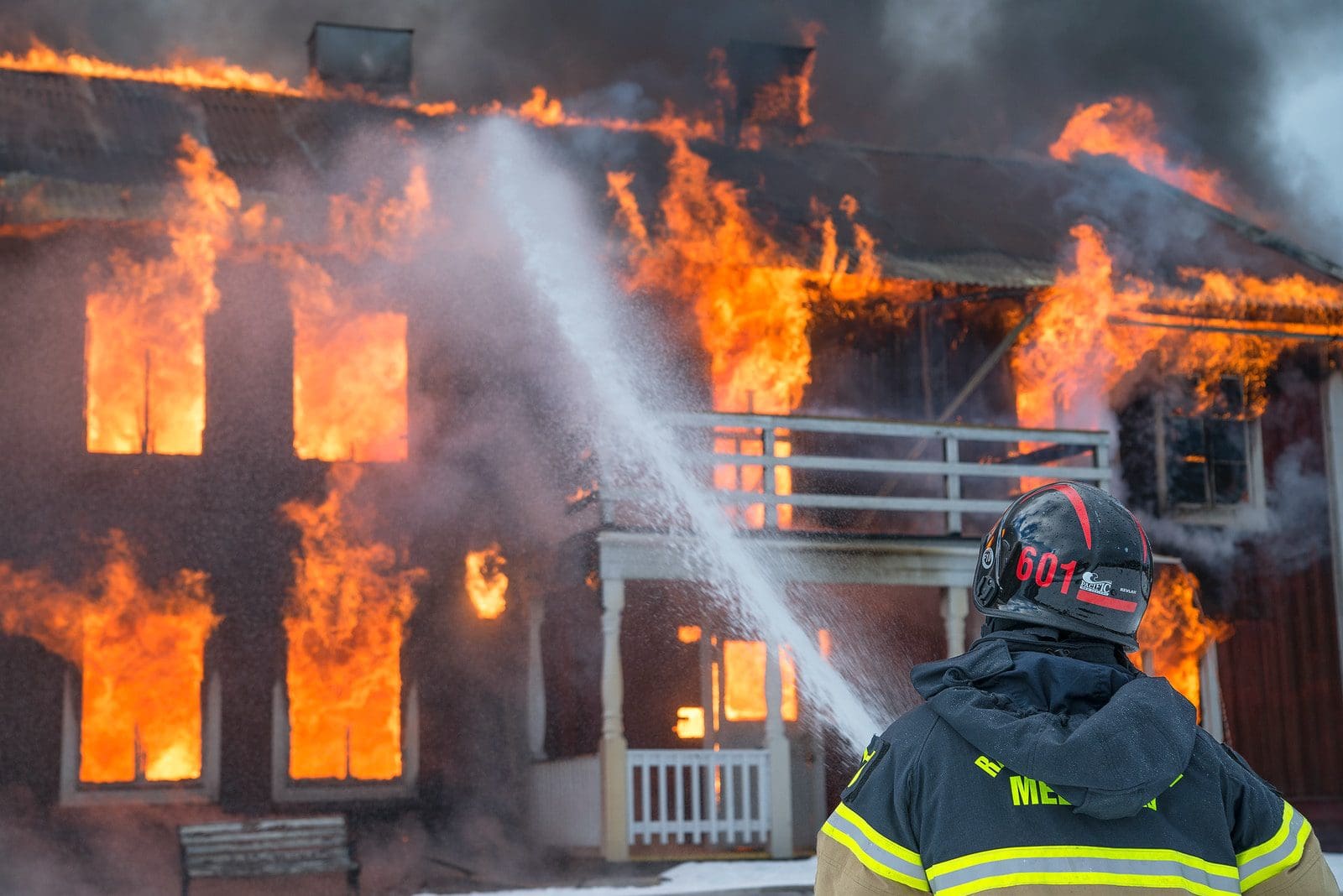Fire insurance protects against financial loss due to damage or destruction of property from fire-related incidents, offering compensation for repair or replacement. Life insurance provides financial protection to beneficiaries in the event of the insured’s death, offering a lump sum or regular payments to support dependents or cover debts.
Key Takeaways
- Fire insurance protects the property against loss or damage due to fire; life insurance provides financial protection for beneficiaries upon the policyholder’s death.
- Fire insurance claims are based on the value of the damaged property; life insurance claims depend on the policy’s coverage amount.
- Fire insurance is primarily for homeowners and businesses; life insurance is for individuals seeking financial security for their dependents.
Fire Insurance vs Life Insurance
The difference between Fire Insurance and Life Insurance is that fire insurance covers the losses caused by the properties of the policyholder. In contrast, life insurance covers the losses that happen to the person of the policyholder.

Comparison Table
| Feature | Fire Insurance | Life Insurance |
|---|---|---|
| Purpose | Protects against financial loss due to damage or destruction of property caused by fire or related perils (e.g., lightning, explosion). | Provides financial security to beneficiaries upon the policyholder’s death or sometimes critical illness. |
| What’s Insured | Physical property (buildings, belongings) | Policyholder’s life |
| Payout | Reimbursement for the repair or replacement of damaged property, up to the policy limit. | Death benefit paid to beneficiaries designated in the policy. |
| Policy Term | Typically one year, renewed annually. | Can vary – term life (temporary coverage) or whole life (permanent coverage with cash value). |
| Cost | Premiums based on factors like property value, location, and fire history. | Premiums based on factors like age, health, policy type, and coverage amount. |
| Indemnification Principle | Applies. The payout aims to restore the policyholder to their pre-loss financial state, not exceeding the actual loss. | Does not apply. The death benefit is a pre-determined amount regardless of the policyholder’s income or financial worth. |
| Investment Component | No | Some whole life policies have a cash value component that grows over time. |
What is Fire Insurance?
Introduction to Fire Insurance
Fire insurance is a type of insurance policy designed to protect property owners from the financial losses incurred due to damage or destruction caused by fire. It provides coverage for both residential and commercial properties, offering a sense of security and financial stability in the face of unexpected fire-related incidents.
Understanding Coverage and Policy Terms
Coverage Details
Fire insurance policies typically cover various aspects related to fire damage, including:
- Structural Damage: This includes the cost of repairing or rebuilding the property’s structure if it is damaged or destroyed by fire.
- Contents Damage: Fire insurance may also cover the loss or damage of personal belongings, furniture, appliances, and other contents within the insured property.
- Additional Perils: Some fire insurance policies may extend coverage to other perils closely related to fire, such as smoke damage, explosions, lightning strikes, or water damage from firefighting efforts.
Policy Terms and Conditions
Fire insurance policies outline specific terms and conditions that policyholders must adhere to, including:
- Premiums: Policyholders are required to pay regular premiums to maintain coverage. Premium amounts are determined based on factors such as the property’s location, value, and fire risk.
- Deductibles: Fire insurance policies often include a deductible, which is the amount the policyholder must pay out of pocket before the insurance coverage kicks in. Higher deductibles typically result in lower premium costs.
- Exclusions: Certain types of damage may be excluded from coverage, such as intentional acts of arson, acts of war, or damage caused by natural disasters like earthquakes or floods. Policyholders should carefully review the policy’s exclusions to understand the extent of coverage.

What is Life Insurance?
Introduction to Life Insurance
Life insurance is a contract between an individual (the insured) and an insurance company, where the insurer promises to pay a designated beneficiary a sum of money upon the death of the insured. It serves as a crucial financial tool to provide protection and support to dependents, ensuring their financial stability in the event of the insured’s demise.
Understanding Coverage and Policy Terms
Coverage Details
Life insurance policies offer various types of coverage, including:
- Death Benefit: The primary component of life insurance, the death benefit is the sum of money paid to the beneficiary upon the insured’s death. This amount is predetermined when the policy is purchased and can provide financial support to cover expenses such as funeral costs, outstanding debts, mortgage payments, and ongoing living expenses for dependents.
- Optional Riders: Policyholders may have the option to add riders to their life insurance policy for additional coverage, such as accidental death benefits, critical illness coverage, or disability income riders, depending on their specific needs and preferences.
Policy Terms and Conditions
Life insurance policies come with specific terms and conditions that policyholders must understand, including:
- Premiums: Policyholders are required to pay regular premiums to maintain coverage. Premium amounts are determined based on factors such as the insured’s age, health, lifestyle, and the desired coverage amount.
- Policy Duration: Life insurance policies can be either term or permanent. Term life insurance provides coverage for a specified period (e.g., 10, 20, or 30 years), while permanent life insurance, such as whole life or universal life, provides coverage for the insured’s entire lifetime.
- Beneficiary Designation: Policyholders designate one or more beneficiaries who will receive the death benefit upon the insured’s death. Beneficiaries can be family members, spouses, children, or other individuals or entities chosen by the policyholder.

Main Differences Between Fire Insurance and Life Insurance
- Fire Insurance:
- Protects against financial loss due to damage or destruction of property from fire-related incidents.
- Provides compensation for repair or replacement of the insured property.
- Coverage is typically limited to specific perils like fire, smoke damage, explosions, and water damage from firefighting efforts.
- Life Insurance:
- Provides financial protection to beneficiaries in the event of the insured’s death.
- Offers a lump sum or regular payments to support dependents or cover debts.
- Coverage is not limited to a specific peril but rather the insured’s life, offering financial security for loved ones upon the insured’s demise.

- https://www.eh.net/page/97/?s=The
- https://www.jstage.jst.go.jp/article/jaee2001/4/3/4_3_154/_article/-char/ja/
- https://authors.library.caltech.edu/9570/1/CABjpe03.pdf

The article covers the essential aspects of fire insurance and life insurance in great detail, making it a well-rounded resource for those looking to broaden their understanding of insurance policies.
This article is a testament to meticulous research and offers a comprehensive guide to understanding fire insurance and life insurance.
Absolutely, Amber17. The in-depth coverage of the topic in this article is truly commendable.
While the article provides detailed information on fire insurance and life insurance, some points could have been presented with a more critical viewpoint for a well-rounded understanding of the topic.
I understand your perspective, Ymitchell. Including various viewpoints could have made the article even more informative.
I share your view, Ymitchell. A critical analysis of certain aspects would have added depth to the article.
This article provides a comprehensive comparison between fire insurance and life insurance. It’s informative and helpful for those looking to understand the differences between the two types of insurance policies.
I agree with you, Sophie. The detailed explanation of the key takeaways and the comparison table makes it easier to understand the nuances of fire insurance and life insurance.
I found the explanation of the difference between fire insurance and life insurance to be very enlightening. It’s important to have a clear understanding of the coverage provided by each type of insurance.
The detailed explanation of fire insurance and life insurance, along with the comparison table, makes this article an excellent reference for understanding the nuances of these types of insurance policies.
I completely agree, Melissa. The article breaks down complex insurance terms into easily digestible information, making it a valuable read.
The detailed explanation of what fire insurance and life insurance entail is very insightful. It’s clear that a lot of thought and research has gone into creating this informative piece.
The thoroughness of the article in explaining the differences between fire insurance and life insurance is truly praiseworthy. It’s a great read for anyone seeking clarity on the subject.
I couldn’t agree more, Sasha. The depth of information provided in this article is commendable and truly enhances the understanding of these insurance types.
The article clearly outlines the duration, compensation, and policies associated with fire insurance and life insurance. It’s a great resource for anyone looking to delve into the details of these insurance types.
I appreciate the emphasis on the differences between the duration and compensation of fire insurance and life insurance. It’s crucial information for policyholders to understand.
The comparison table is very well-structured and provides a quick reference to the varying aspects of fire insurance and life insurance. It’s a valuable addition to the article.
The article offers a clear and concise definition of both fire insurance and life insurance, making it easier to comprehend their respective scopes and benefits.
This is a very comprehensive and well-researched article, outlining the key details of fire insurance and life insurance. It’s certainly a valuable resource for anyone wanting to familiarize themselves with these insurance types.
Absolutely, Danielle. The information provided here is presented in a manner that’s easy to understand, making it highly beneficial for readers.
The article effectively delineates the key aspects of fire insurance and life insurance, providing valuable insights for readers seeking to understand these insurance types.
I couldn’t agree more, Sean. The article’s structured approach to explaining the nuances of fire insurance and life insurance is highly commendable.
The article is an informative and thorough guide to understanding the nuances of fire insurance and life insurance, providing readers with valuable insights into these insurance types.
I share your view, Hughes Jasmine. The depth of information presented in this article truly enriches the understanding of fire insurance and life insurance.